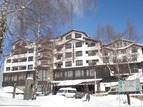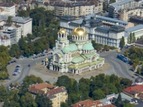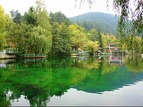Hotels in Sofia
Vitosha Nature Park and surroundings
The magnificent mountains which surround Sofia are one of the most preferred places to visit whilst being in Bulgaria’s capital city. Vitosha. Liulin and Plana Mountains encircle Sofia city. Certainly all of them feature wonderful nature, breathtaking sceneries, crystal clear air, unique culture sites and attractive eco trails to explore. Unfortunately, time is not something that all of us have in abundance, so we have put the emphasis here on the Vitosha Mountain, and Vitosha Nature Park in particular.
Vitosha Mountain Overview
Vitosha Montain lies in the centre of Southwestern Bulgaria between Stara Planina Mountain and Rila-Rhodopes massif. It is the only hilly mountain in the country. Sofia is situated at the foothills of Vitosha Mountain and this adds some attraction to the oldest Nature Park on the Balkan Peninsula.
Vitosha is one of the symbols of Bulgaria’s capital and the closest site for hiking, trekking, alpinism and skiing, or simply exploring unique nature. Convenient bus lines and rope ways make the mountain easily accessible, so no excuses if you don’t visit it.
Vitosha is a unique mountain! Visit it and reveal an inspirational world of natural beauty, discover something new and unfamiliar. The longest cave in Bulgaria, the lush vegetation variety, the unique stone rivers, the rich water resources, the close proximity to Sofia provoke a great interest in it.
Unique structure: Stone rivers are typical for the mountain. They were formed by rock evaporation and their slow movement to the valleys is a result of flowing water gravitation.
Abundance of Water resources: The mountain is extremely rich in water resources – numerous springs and torrents that give the beginning of many rivers. The biggest Vitosha’s river is Struma River which flows into White Sea. Even the drought months cannot dry up the rivers because they are fed by the peats.
Vitosha is also the cradle of hiking tourism in Bulgaria. The date 27 August 1895 is considered the beginning of the organised tourist movement in the country. After the invitation of the renowned writer and democrat Aleko Konstantinov, 300 men and women then climbed Mt. Cherni Vrah – which was incredible at that time. Since then thousands of hikers climb the peak every year on this day.
Vitosha Nature Park-the Oldest on the Balkan Peninsula
Vitosha Nature Park is situated within the Vitosha-Ihtiman landscape sub-region. Vitosha Nature Park is the oldest Nature Park on the Balkan Peninsula. The nature park spreads over 27 079.114 ha or 55% of the total area of the sub-region comprising up to 479 100 ha. Within the park there are 10 differed genetic groups from mountain landscape class. The landscapes of medium-high Mountain coniferous-deciduous forests upon massive and metamorphic rocks /34% or 9085.1 ha/ spread over large territories. There is a great number of water and water-surrounding landscapes that have a large quantity of water flow. Along the ridges within the higher belt there are meadows, marshes and peats.
The contemporary Vitosha Nature Park completely belongs to the recreation landscapes which are influenced sometimes by different human activities.
The great number tourists who visited Vitosha Nature Park are amazed at its inspiring landscape, diverse flora and rich fauna. The coniferous forests as well as the subalpine meadows are home to many interesting birds like Tengmalm’s Owl, Honey Buzzard, Sparrowhawk, Black Woodpecker, Pallid Swift, Ring Ouzel, Rock Thrush, Black Redstart, Crag Martin, Firecrest and Goldcrest, Alpine Accentor, Dunnock, Water Pipit, Nutcracker. During winter the species list is not so long, but Black Woodpeckers, Firecrest and Goldcrest, Nutcrackers and different small passerines could easily be noted while enjoying the impressive panorama of Sofia and its vicinity from a bird’s eye view.
Within the territory of Park Vitosha 1489 species of higher plants have been described. The diversity here is rich as this number represents one half of the total species for Bulgaria. Nine of these species can only be found in Bulgaria, 13 are Balkan endemics, and 58 are included in the Red Book of Bulgaria.
Scenic Landscapes
Forest landscapes are of greatest significance for the recreation and they are mainly used for ecological background or aesthetic element. Most landscapes are of great importance for summer and winter recreation activities as well for the road and trail network. Some water landscapes are very attractive, especially the ones in combination with meadows, forests and rocks that have para-glacial forms as well as the water-surrounding marshes and torfaceous landscapes.
Flora:
The vegetation of Vitosha includes relict species that survived the last geological ice age. An example of such a species is Pinus peuce, a tertiary relict that occurred only on the Balkan Peninsula. Within the borders of the park is one of only two remaining habitats of another tertiary relict – Taxus baccata (yew). This population is located near Boyana waterfall at the point where the Petrovichka River crosses the path from Boyana to the rest house “Esperanto”.
Protected areas within the area of Vitosha Nature Park
The Bistrishko Branishte reserve is located on the eastern slope of Vitosha under the peaks Big and Little “Rezen”. It includes the upper streams of Bistritsa and Yanchovska rivers, which spring from the stone moraines under the previously mentioned peaks. It conserves a spruce forest in the sub-alpine zone that is 100 to 120 years old with trees with an average height of 25 m. In 1977 the reserve was declared a UNESCO Biosphere Reserve (under the program “Man and the Biosphere”) as part of a network of 16 Bulgarian reserves. They were created to preserve the areas representing the main ecosystems on Earth.
This world net of Biosphere reserves aims to preserve the world’s natural wealth for scientific research, human interest, and for its intrinsic value.
Peat Branishte reserve
The territory of the Peat Branishte reserve has awesome water containing properties; it functions as a basin to catch water, resulting in a unique and important ecosystem. The reserve was established to conserve a significant part of the 1000 to 1500 year old peat deposits, which grows on average 1 mm per year.
Located within Peat Branishte is the origin of three different rivers – Zanchovska, Bistrishka, and Vladazska. The reserve maintains unique bog vegetation at the Vitosha high mountain belt. There are co-habitants of about 300 moss species, 500 varieties of algae, and low willows.
Vitosha Nature Park-official website
Vitosha Mountain-natural and cultural monuments
The mountain offers a number of valuable culture monuments, the most interesting of which are Boyana Church, National History Museum, and The Dragalevtsi Monastery, founded under the reign of Tsar Ivan Alexander in the middle of the 14th century. Boyana church and the Dragalveski monastery were built during the 13th and 14th century and are regarded as predecessors of European Renaissance. The Boyana Church is included in the UNESCO World Heritage List.
Zlatnite Mostove (Golden Bridges) is a popular tourist centre, located at an altitude of 1400m above sea level in the Vladaya subpart of the Northern Range of Vitosha. There are marked hiking routes in the area, so those of you keen on trekking and hiking will not be disappointed to spend a couple of hours in the Vitosha Mountain.
Besides cultural landmarks Vitosha is recognized attractive ski venue near Sofia as it is easily accessible from the city.
The Boyanski Waterfall, Vitosha’s stone rivers and Bulgaria’s longest cave Duhlata are some of the natural phenomena found within the Vitosha area.
Duhlata-the longest cave in Bulgaria
At the foot of the southern slopes of the mountain, in the Bosnek-Carst region, lies the longest and most spectacular cave in Bulgaria - Duhlata Cave. which stretches for 17.5 km, with 16 galleries found on seven levels, and has six ground streams. It was formed in the limestone by the Strouma river system and consists of a variety of stalactite and stalagmite formations. Here one can find a very unique composition of underground fauna which has not been fully examined. However, examples are known of marine organisms from ancient seas that have adapted morphologically and physiologically to an underground way of life.
Ancient Thracian artifacts (coins and ceramic items) have been found near the entrance of Duhlata Cave and thus indicating historical inhabitation in the area. Also, in the proximity of Little Duhlata Cave, Thracian burial grounds dated from the 10th C have been found along with a golden horn instrument. Unfortunately, thus far only the caves Duhlata and Living Water have been researched.
Nearby is the Living Water spring, the only limestone spring on the mountain, named so because of the rhythmic on-off flows of its water. A picnic area is located at the spring to accommodate visitors.
Vitosha Nature Park on the map of Sofia
Other Parks & nature in Sofia
Hotels in Sofia





- Anel Hotel
- Arena di Serdika Boutique Hotel
- Grand Hotel Sofia
- Hilton Sofia Hotel
- Holiday Inn hotel
- Hyatt Regency Sofia Hotel
- Intercontinental Sofia (ex Radisson Blu Grand Hotel)
- Sofia Hotel Balkan a Luxury Collection Hotel (ex Sheraton Hotel)




- Best Western Hotel Europe
- Best Western Premier Sofia Airport
- Central Hotel
- City Hotel
- Crystal Palace Hotel
- Downtown Hotel
- Festa Sofia Hotel
- Geneva Hotel
- Gloria Palace Hotel
- Hill Hotel
- Hotel Coop
- Hotel Zoo Sofia
- Les Fleurs Hotel
- Metropolitan hotel
- Novotel Sofia
- Ramada by Wyndham Sofia City Center
- Rodina Hotel
- Rosslyn Central Park Hotel
- Rosslyn Thracia Hotel
- Salt Palace Hotel
- Sveta Sofia Hotel
- The Stay Hotel Expo Center
- VEGA Hotel Sofia
- Vitosha Park Hotel



- Akord Hotel
- Aleksander Palace - Advi
- Arte Hotel
- Best Western Losenets Hotel
- Best Western Plus Bristol
- Brod Hotel
- Budapest hotel
- Earth and People hotel
- Hemus Hotel
- Legends hotel
- Light hotel
- Lion Hotel
- Maxim Hotel
- Meg-Lozenets Hotel
- Montecito Hotel
- Park Hotel Moskva
- Rocentro /ex Renaissance Hotel/
- Slavyanska Beseda Hotel
- Sofia Place Hotel


- Medic Hotel
Upcoming events in Sofia
- Sofia Dance Week 2010
- Art festival in Sofia city
- Scorpions in Sofia city 2010
- International Feline Show in Sofia
- Paco De Lucia performs in Bulgaria
- Drumset Competition 2010- Sofia Drum Day
- TOP 100 DJs party Monarchy performs in Bulgaria
- Chris Norman performs in Bulgaria 2010
- Harlem Gospel Choir performs in Bulgara
- Yann Tiersen's concert for Students Holiday
- Disco Legends Boney M concert in Bulgaria
- Legendary Firewind performs in Sofia
- Barclay James Harvest performs in Bulgaria
- Vaya Con Dios in Bulgaria
- 15th Sofia International Film Festival
- Absent Minded
- Concert of the queen of fado Marisa in Sofia, Bulgaria
- Guano Apes in Bulgaria
- Toto Cutugno in Bulgaria
- Manu Chao in Sofia city
- Children of Bodom in Bulgaria
- Alphaville in Sofia
- Rosalia de Souza in Bulgaria
- Vassil Vassilev and Chambao
- 100 Gypsy Violins in Bulgaria
- Raul Midon in Bulgaria
- Omega- the most successful Hungarian Rock Band gigs in Bulgaria
- Joe Cocker
- Roxette in Sofia, Bulgaria 2011
- Isthar in Sofia city
- Sting in Bulgaria
- CINDERELLA & MR.BIG in Bulgaria
- Dragana Mircovich and Vesna Zmijanac gig in Bulgaria
- Michel Legrand in Bulgaria
- Linkin Park in Bulgaria
- Mellow Music Festival
- Omara Portuondo and Buena Vista Social Club in Bulgaria
- ARASH feat. Rebecca concert in Bulgaria
- Mor Karbasi’s concert in Bulgaria
- Alice Russel in Sofia city
- Gipsy Kings gig in Bulgaria
- Jean Michel Jarre in Bulgaria
- Eric Sardinas concert
- Pooh gigs in Bulgaria
- Manhattan Transfer's concert in Bulgaria
- Hindi Zahra’s concert in Bulgaria
- Amon Amarth concert in Bulgaria
- Sade gigs in Bulgaria in November
- Genesis gigs in Bulgaria
- Julio Iglesias concert
- Sofia Rocks festival 2012
- Jennifer Lopez- concert in Bulgaria
- Depeche Mode performs in Bulgaria in May 2013
Places to go in Sofia
- St. Alexander Nevski Cathedral
- Boyana Church
- National Museum of History
- Alexander Nevsky Crypt Icon museum
- Vitosha Nature Park
- “Ivan Vazov” National Theatre
- The St. Petka Samardjiska Church /St. Petka of the Saddlers/
- Borisova Gradina Park (Central Park)
- Bulgarian National Gallery for Foreign Art
- St. George Rotunda-the oldest Eastern European Orthodox church
- Bulgarian National Gallery of Arts
- National Archaeological Museum
- Fountains in Sofia
- Public gardens and green areas
- St. Sofia church- ancient Eastern Orthodox church in Sofia
- St. Nikolay Russian church
- Sofia botanical garden
- Church of the Holy Seven
- Sofia Zoo
- Bulgarian Natural History Museum
- Sofia City Art Gallery
- Pancharevo lake
- Ethnographic Museum
- St. Nedelya church
- Museum of Earth and Man
- Sofia University Botanic Garden
- Cathedral of St Joseph
- Independence Square
- Boyana waterfall
- Alexander Nevski Square
- King Alexander Battenberg Square
- National Assembly's building in Sofia
- Tsar Osvoboditel Boulevard
- Vitosha Boulevard
- St. Paraskeva Church
- Eagle's Bridge
- Atanas Burov Square
- St. 40 Martyrs Church
- Oborishte street
- Rila monastery
- Slaveikov square
- National Palace of Culture
- National Library St. St. Cyril and Metodius
- Banya Bashi Mosque
- Jewish synagogue in Sofia
- Lion's bridge
- Law Courts
Deals & discounts in Sofia
News from Sofia
- Bulgaria’s National history museum included in the EU project “Museums present Europe”
- International Festival of the Masquerade Games in Pernik town, Bulgaria
- Ice Bar in Sofia city
- Burgas, Varna, Sofia – included in 100 Global Cities Destination Ranking
- Skiing in Vitosha mountain
- Sofia hotels in top 10 capital cities worldwide
- Festival “Skiing and snowboarding in the city” is held in Sofia
- Days of challenges in Sofia city
- Bon Jovi visits Bulgaria in 2013
- No restored ski equipment at Vitosha Mountain
- New cultural and historic route Sveta Gora
- International kids folklore festival in Sofia city
- Low cost flights from Sofia airport to Budapest
- Ski competition at Vetrovala in Vitosha Mountain today
- 16th International Sofia Movie festival
- Sofia is the cheapest holiday destination in Europe
- Christmas traditions will be presented in Ethnographic museum in Sofia
- Central Mineral bath in Sofia becomes a museum and SPA centre
- Sofia is the cheapest holiday destination in Europe
- 3 Airline Carriers Stop Winter Flights to Sofia
- A growth of 6,6% of passengers at Sofia airport
- Tourist information centre opened at Sofia Airport
- Gipsy Kings performance is postponed
- French Movie Festival in Sofia city
- Cheapest hotels in Sofia city
 Member of:
Member of:





































































 Touroperator
Touroperator
